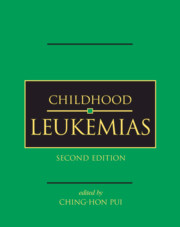Book contents
- Frontmatter
- Contents
- List of contributors
- Preface
- Part I History and general issues
- Part II Cell biology and pathobiology
- 4 Anatomy and physiology of hematopoiesis
- 5 Hematopoietic growth factors
- 6 Signal transduction in the regulation of hematopoiesis
- 7 Immunophenotyping
- 8 Immunoglobulin and T-cell receptor gene rearrangements
- 9 Cytogenetics of acute leukemias
- 10 Molecular genetics of acute lymphoblastic leukemia
- 11 Molecular genetics of acute myeloid leukemia
- 12 Apoptosis and chemoresistance
- 13 Heritable predispositions to childhood hematologic malignancies
- Part III Evaluation and treatment
- Part IV Complications and supportive care
- Index
- Plate Section between pages 400 and 401
- References
12 - Apoptosis and chemoresistance
from Part II - Cell biology and pathobiology
Published online by Cambridge University Press: 01 July 2010
- Frontmatter
- Contents
- List of contributors
- Preface
- Part I History and general issues
- Part II Cell biology and pathobiology
- 4 Anatomy and physiology of hematopoiesis
- 5 Hematopoietic growth factors
- 6 Signal transduction in the regulation of hematopoiesis
- 7 Immunophenotyping
- 8 Immunoglobulin and T-cell receptor gene rearrangements
- 9 Cytogenetics of acute leukemias
- 10 Molecular genetics of acute lymphoblastic leukemia
- 11 Molecular genetics of acute myeloid leukemia
- 12 Apoptosis and chemoresistance
- 13 Heritable predispositions to childhood hematologic malignancies
- Part III Evaluation and treatment
- Part IV Complications and supportive care
- Index
- Plate Section between pages 400 and 401
- References
Summary
Introduction
The development of chemoresistance in tumors is a major obstacle in oncology, particularly in the treatment of acute myeloid leukemia. Resistance to therapy can be broad (multidrug resistance) and arise de novo, but is more frequently acquired following the relapse of disease in patients previously treated with chemotherapy. The chemoresistance phenotype can arise through several mechanisms including: (1) overexpression of the P-glycoprotein family of membrane transporters (MDR1, MRP, LRP), which decrease the intracellular levels of anticancer drugs; (2) changes in cellular enzymes that detoxify or metabolize drugs, such as dihydrofolate reductase and cytochrome p450 enzymes; and (3) changes in enzymes intimately involved in DNA repair, such as DNA topoisomerase II. A fourth and more general mechanism involves changes in the expression and/or activity of proteins that regulate apoptosis, an endogenous program of cell suicide that disassembles the cell when it has received damage or oncogenic insults. Given the number of regulators that feed into the apoptotic response, understanding this mechanism of resistance is now recognized as a significant challenge; however, targeting these regulators holds great promise of overcoming or bypassing drug resistance in relapsed cancer patients.
For many years, radiation treatment and chemotherapy were thought to cause irreparable metabolic or physical damage to cancer cells, resulting in cell necrosis.
- Type
- Chapter
- Information
- Childhood Leukemias , pp. 339 - 361Publisher: Cambridge University PressPrint publication year: 2006



